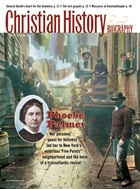At certain times during the Christian era, social, spiritual, and political forces have converged to create an environment primed for a revival. Such an alignment occurred exactly 150 years ago—seemingly a most unlikely time for God to do a new thing.
In Britain, Queen Victoria ruled over a vast bureaucratic Empire, but even outside the British sphere of influence, the Victorian Age was characterized by a love of orderliness and a sense of upper-class Anglo-Saxon superiority—what Rudyard Kipling infamously labeled "the white man's burden." Notably, it was also the time of the industrial revolution: a birth of factories and mass production. Their era's prosperous, mechanizing mood affected not only the way Victorians treated their servants and made their furniture, but also the way they preached the Gospel.
That is, until 1854. In that year, three men launched ministries that would shake their comfortable churches to the core.
Hudson Taylor (1832-1905)
The first rule of medicine is that a doctor should do his patient no harm. It might equally be said that the first rule of evangelism is that anyone preaching the Gospel should not condemn his listeners. What the pioneering missionary Hudson Taylor found upon arriving in China in 1854, however, was that the Western missionaries who had preceded him openly disdained and criticized their Chinese flock. His response changed missions then and now.
When the Taiping Rebellion broke out in 1851, its leaders claiming to embrace Christianity, Western mission societies had jumped at the chance to enter the country with the blessings of a new regime. Taylor, the son of a Methodist preacher, joined the rush, landing in Shanghai just before his 22nd birthday.
Once on this hot, war-torn, and disease-ridden mission field, the young man found that most of his fellow missionaries thought the prospects for evangelism dim. Many congregated in comfortable Western enclaves rather than venturing into the country's squalid interior. Their condescending attitudes toward the Chinese did nothing to reassure the peasants, who suspiciously viewed them as Western imperialists.
Deeply troubled, Taylor returned to England six years later and literally rewrote the book on Chinese evangelism. In China, Its Spiritual Need and Claims, he said, "What does the Master teach us? Is it not that if one sheep out of a hundred be lost, we are to leave the ninety and nine and seek that one? But here the proportions are almost reversed, and we stay at home with the one sheep, and take no heed to the ninety and nine perishing ones!"
He had already severed ties with his sponsor, the China Evangelization Society, and now he created the China Inland Mission, the policies of which, he intended, would undo the errors made by previous agencies.
Taylor returned to China in 1866, and throughout the years that followed he disagreed sharply with British policies and worked to build a mutual respect between his mission workers and the Chinese. On one occasion after locals looted and burned his mission outpost, British gunboats steamed up the Yangtze River to exact retribution. Taylor, however, refused to bring any charges against the arsonists and returned to re-establish his mission. Likewise, following the Boxer Rebellion of 1900 in which many British missionaries lost their property, the British government imposed fines on the Chinese by way of compensation. But Taylor would not accept any of the money, saying that the Chinese themselves had lost even more.
Taylor summed up his approach: "Quietly settling among the people, obtaining free, familiar, and unrestrained communication with them, attracting their esteem and confidence, and so living as to be examples to them of what Chinese Christians should be." To this end (and to the shock of those back home), Taylor began wearing Chinese dress and adopting their customs.
Taylor's policy of meeting the Chinese on their own terms produced remarkable results. By the time of his death, he had established 20 mission stations throughout China, collected a team of 849 missionary associates, and overseen the growth of a Chinese church of 125,000 souls.
Charles Spurgeon (1834-1892)
In 1861, Charles Haddon Spurgeon wrote that the Church of England, by its dependence on empty ritual, was "ruining souls, and turning this nation to … infidelity." Poverty, he also noted, most afflicted those European countries where church ritualism most prospered. For Spurgeon, the lesson was clear: ritual without compassion is dead.
Spurgeon's critique was not calculated to win him friends. But he was acting in the long non-conformist tradition of Essex, his home county. John Bunyan, author of Pilgrim's Progress, who had been jailed for his religious principles, was one of his heroes.
Spurgeon was 15 when an accidental encounter cemented this Puritan zeal. He entered a church to take shelter from a snow squall. The preacher was reading from Isaiah 45: "Look upon me and be saved." Spying Charles standing by himself, he interrupted his sermon to note, "That young man there looks very miserable," and to urge Spurgeon to consider the Scripture he had just read. On his way home, Spurgeon realized in a flash the power of God's grace. Within a year, he began preaching the Gospel himself, and in the momentous year of 1854, he became the pastor of London's Park Street Chapel.
During his first three years of preaching, mostly at a Baptist church in Cambridgeshire, Spurgeon discovered that he possessed a rare talent for speaking. But he also learned that his parishioners were not moved so much by ritual or religious jargon as by simple, honest talk and sincere compassion.
Many times, he must have looked out over the congregation from the pulpit and thought, "That fellow there looks very miserable." In response, he addressed their physical as well as their spiritual misery, launching social ministries such as the Stockwell Orphanage for indigent children.
"I feel that the best way to lift up the lost and degraded from the horrible pit and miry clay is to preach Jesus Christ and him Crucified," Spurgeon wrote, "but this need not prevent me from using all possible measures to promote social reform."
The London establishment, which preferred to wrap the Gospel in a more sophisticated but often ethereal package, disdained Spurgeon's hands-on approach: "All the most solemn mysteries of our holy religion are by him rudely, roughly, and impiously handled," complained one critic.
However, Spurgeon's compassion proved more effective than the establishment's ritual: attendance at Park Street grew from 80 in 1854 to 5,000, then to 10,000.
Spurgeon's London was the grimy, work-house London immortalized by Charles Dickens. His parishioners may not have been sophisticated, but they could well understand the need for grace. And he, too, knew of suffering—chiefly from rheumatism, of which he ultimately died.
In this shared pain, though, Spurgeon saw a divine purpose. He believed suffering penetrates selfishness and pride, and humbles us in preparation for answering God's call on our lives. This message gave meaning to dark times and brought Londoners by the thousands to a new understanding of God's grace.
Sören Kierkegaard (1813-1855)
A preacher looking for a shining example of Christian charity would probably never settle on the early life of the Danish philosopher Sören Kierkegaard. The pivotal event during these years was his quixotic relationship with Regina Olsen. Although she was then seeing someone else, Sören became infatuated with Regina and persuaded her to end her previous relationship. He then proposed marriage, and she accepted.
Then Kierkegaard had a change of heart. But rather than break the engagement himself, he began behaving obnoxiously so Regina would get fed up and leave him, and thus bear the stigma of ending the relationship.
The guilt he felt over this episode led Kierkegaard to question his own faith and the impact of society on faith. He began pondering a paradox: How is it possible to become truly Christian in Christendom? To his eyes, far from producing energized Christian individuals, the established institutions of his day churned out bland, mindless drones with little understanding of their own identity or sense of responsibility.
Kierkegaard set for himself the task of shaking up the established social order. He took his inspiration from Socrates, who had forced his disciples to think for themselves by constantly questioning their assumptions.
For Kierkegaard, the most troubling aspect of traditionalism was the barrier it had erected between Christians and the saving grace of God. He perceived that faith, for many, had become nothing more than the rote parroting of the liturgy. In contrast to this institutional form of religion, he wrote, true Christian faith must be passionate and based on personal experience.
Between 1854 and 1855, Kierkegaard wrote 21 articles attacking the Danish institutional church for its neglect of the essential teachings of Christ and its undue reliance on its own form and ritual. His writings reintroduced his generation, and each one since, to a God with whom we are meant to live in heartfelt relationship, not to study analytically.
A fatal stroke cut this literary explosion short and stilled Kierkegaard's pen, but his ideas continued to percolate. As the trends that prompted his writing became even more prevalent in subsequent years, his work seemed to grow more relevant, and eventually it had even more impact on 20th-century thinking than on his own age.
© Copyright by the author or Christianity Today/Christian History & Biography magazine.
Click here for reprint information on Christian History & Biography.

Support Our Work
Subscribe to CT for less than $4.25/month




























